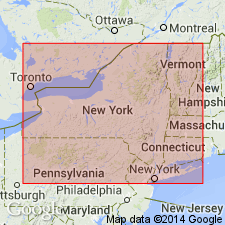
- Usage in publication:
-
- Erie group
- Modifications:
-
- Original reference
- Dominant lithology:
-
- Shale
- Sandstone
- Limestone
- AAPG geologic province:
-
- Appalachian basin
Summary:
Pg. 100, 429. Erie group. Named from Lake Erie, the valley of which is excavated out of Ludlowville shales, shaly sandstones, etc., which compose it. Includes Chemung and Ithaca shales and grits, Genesee slate, Tully limestone, and Hamilton and Marcellus shales. Is top group of New York system. Overlies Hedlerberg series, which includes at top Schoharie grit and overlying Helderberg [Onondaga] limestone. Underlies Old Red sandstone. Age is Middle and Late Devonian.
Source: US geologic names lexicon (USGS Bull. 896, p. 694-695).
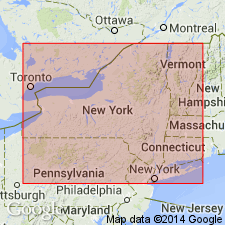
- Usage in publication:
-
- Erie division
- Modifications:
-
- Revised
- AAPG geologic province:
-
- Appalachian basin
Summary:
Erie division. Includes Chemung group at top and Marcellus shales at base. [Used in this sense by James Hall (1843), W.W. Mather (1843), and other geologists.]
Source: US geologic names lexicon (USGS Bull. 896, p. 694-695).
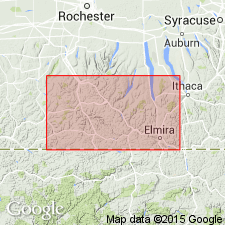
- Usage in publication:
-
- Erie
- Modifications:
-
- Revised
- AAPG geologic province:
-
- Appalachian basin
Summary:
The Portage and Chemung form an invisible mass of mechanical sediments, of which both fossils and lithological characters contrast strongly with underlying Hamilton and is evidently the record of a new era in geologic history of continent. This new group I have called the Erie, and I think it will be found to belong both by its fossils and its physical relations, rather with the Carboniferous than the Devonian system.
Source: US geologic names lexicon (USGS Bull. 896, p. 694-695).

- Usage in publication:
-
- Erian or Devonian
- Modifications:
-
- Overview
- AAPG geologic province:
-
- Appalachian basin
Summary:
In 1879 T. Sterry Hunt included in his Erian or Devonian all beds between top of Catskill and base of Oriskany.
Source: US geologic names lexicon (USGS Bull. 896, p. 694-695).
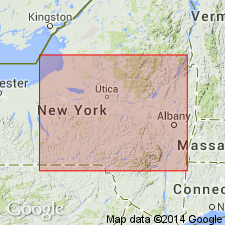
- Usage in publication:
-
- Erian period
- Modifications:
-
- Revised
- AAPG geologic province:
-
- Appalachian basin
Summary:
Erian period or group. The "Erie division" comprised the formations from top of Onondaga limestone to top of the Chemung. We propose to save the term to New York nomenclature by reviving it with a restricted meaning; to include the rocks between Tully limestone and Onondaga limestone.
[This definition has been generally followed, except that in 1910 Schuchert (GSA Bull., v. 20, p. 541) included the Onondaga as did G.H. Ashley, 1923 (Eng. and Mining Jour.-Press, v. 115, p. 1106-1108), who proposed that it be called Erie series.]
Source: US geologic names lexicon (USGS Bull. 896, p. 694-695).

- Usage in publication:
-
- Erian series
- Erie group
- Modifications:
-
- Overview
- AAPG geologic province:
-
- Appalachian basin
Summary:
The USGS does not use Erian or Erie in its classification. The present [ca. 1938] New York State Survey includes in its Erian the beds below Tully limestone and above Onondaga limestone. (See W. Goldring, New York State Mus. Hdbk., no. 10, 1931, p. 370.)
Source: US geologic names lexicon (USGS Bull. 896, p. 694-695).
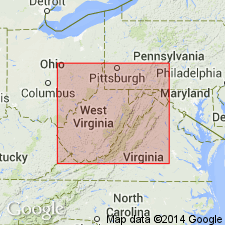
- Usage in publication:
-
- Erie group
- Erian
- Modifications:
-
- Areal extent
- AAPG geologic province:
-
- Appalachian basin
Summary:
Pg. 253, 254, 308-311. Erie group (Erian) of West Virginia contains two members, Marcellus black shale below and Hamilton formation above. Name, which is currently in use by New York State Museum but not by the USGS, is here adopted to resolve a difficulty which otherwise would call for erection of a new term or transfer of another term not yet known to be wholly appropriate. To serve as the name of the Marcellus-Hamilton group of this report (that is, the Hamilton group of Pennsylvania) recourse is had to Erie, or Erian, early used by Emmons (1842) and redefined by Clarke and Schuchert (1899, Science, n.s., v. 10) expressly for this service --namely, for the rocks between the Onondaga and Tully limestone.
Source: US geologic names lexicon (USGS Bull. 1200, p. 1276).
For more information, please contact Nancy Stamm, Geologic Names Committee Secretary.
Asterisk (*) indicates published by U.S. Geological Survey authors.
"No current usage" (†) implies that a name has been abandoned or has fallen into disuse. Former usage and, if known, replacement name given in parentheses ( ).
Slash (/) indicates name conflicts with nomenclatural guidelines (CSN, 1933; ACSN, 1961, 1970; NACSN, 1983, 2005, 2021). May be explained within brackets ([ ]).

